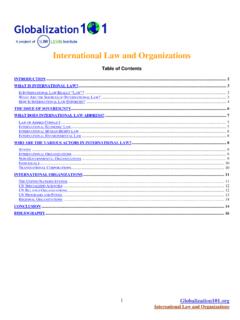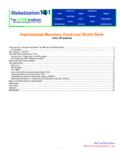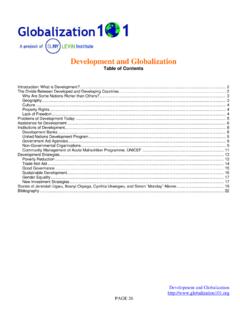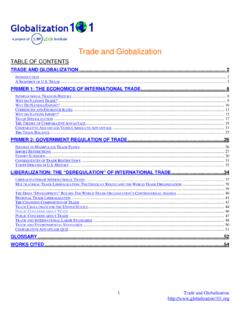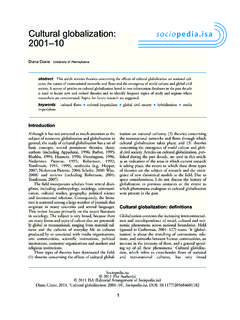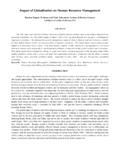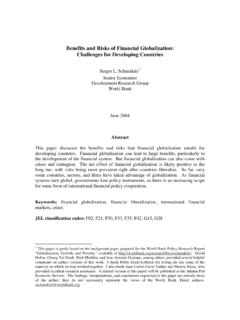Transcription of Technology and Globalization
1 Technology and Globalization 1 Technology and Globalization Table of Contents Technology and Globalization .. 2 Introduction .. 2 The Impact of Information Technology .. 5 Industrial Structure and Jobs .. 5 Workforce .. 7 Financial 7 Benefits .. 8 Short-Term Capital Concerns .. 9 Improving Sectors of Society: Health, Education, Journalism, and 12 Health Care .. 12 Education .. 13 Journalism and Media .. 15 18 Technology in Warfare .. 19 WWI & WWII .. 19 Weapons of Mass Destruction .. 20 Modern Warfare .. 21 Web 24 Social Networking Sites .. 24 Peer Production: A Mighty Fortress of Collective Creativity .. 28 Open Source .. 29 Concerns of the Technological Age .. 32 The International Digital Divide .. 34 Privacy and Security Concerns .. 36 Conclusion .. 37 Ellie Walton and Sunju Ahmadu, young filmmakers .. 38 Glossary Of Terms .. 40 Bibliography .. 42 Technology and Globalization 2 Technology and Globalization Introduction In nearly every corner of the world, from Mumbai to Madrid, one cannot enter a caf or walk down the street without seeing someone talking, texting, or surfing the Internet on their cell phones, laptops or tablet PC.
2 Information Technology (IT) has become ubiquitous and is changing every aspect of how people live their lives. Recent advances in our ability to communicate and process information in digital form a series of developments sometimes described as an "IT revolution" are reshaping the economies and societies of many countries around the world. Picture Source: Technology IT is a driving factor in the process of Globalization . Improvements in the early 1990s in computer hardware, software, and telecommunications greatly increased people s ability to access information and economic potential. While advancements in Internet-based tools over the past five to ten years, such as social networking websites, twitter, and other applications are changing the way people use and share information for personal, political, and commercial purposes. These developments have facilitated efficiency gains in all sectors of the economy. IT drives the innovative use of resources to promote new products and ideas across nations and cultures, regardless of geographic location.
3 Creating efficient and effective channels to exchange information, IT has been the catalyst for global integration. Products based upon, or enhanced by, information Technology are used in nearly every aspect of life in contemporary industrial societies. The spread of IT and its applications has been extraordinarily rapid. Just 30 years ago, for example, the use of desktop personal computers was still limited to a fairly small number of technologically advanced people. The overwhelming majority of people still produced documents with typewriters, which permitted no manipulation of text and offered no storage. Twenty years ago, large and bulky mobile telephones were carried only by a small number of users in just a few cities. According to a 2013 International Telecoms Union (ITU) World Report, there were billion cell phone subscriptions worldwide at the end of 2012. Global mobile cellular penetration reached 96 percent in 2012 (ICT Facts and Figures, 2013).
4 In some developing countries, mobile phones are used by more people than the fixed line telephone network. But perhaps most dramatically, just fifteen years ago, only scientists were using (or had even heard about) the Internet; the World Wide Web was not up and running, and the browsers that help users navigate the Web had not even been invented yet. Today, of course, the Internet and the Web have transformed commerce, creating entirely new ways for retailers and their customers to make transactions, for businesses to manage the flow of production inputs and market products, and for job seekers and job recruiters to find one another. According to ITU World Report 2013, the total amount of users reached more than billion (39 percent of the world s population) by 2013. The news industry was dramatically transformed by the emergence of numerous Internet-enabled news-gathering and dissemination outlets. Websites, blogs, instant messaging systems, e-mail, social networking websites, and other Internet- Technology and Globalization 3 based communication systems have made it much easier for people with common interests to connect, exchange information, and collaborate with each other.
5 Education at all levels is continually transforming thanks to innovations in communication, education, and presentation software. Websites now serve as a primary source of information and analysis for the masses. Globalization accelerates the change of Technology . Every day it seems that a new technological innovation is being created. The pace of change occurs so rapidly many people are always playing catch up, trying to purchase or update their new devices. Technology is now the forefront of the modern world creating new jobs, innovations, and networking sites to allow individuals to connect globally. The timeline below shows the rapid transformation of how Technology has accelerated within the last 20 years to 2012. 18 years ago: Internet commercialized 17 years ago: first mobile phone with Internet connectivity 15 years ago: Google named the search engine of choice by PC magazine 12 years ago: Blackberry launched 9 years ago: Facebook launched 7 years ago: Twitter launched 6 years ago: iPhone, the first of the smart phones, introduced 5 years ago: Groupon introduced 3 years ago: 17 million smart tablets sold estimated that 100 + million by 2014 1 year ago: Google Glass announced Every 60 seconds (so it seems): new apps, tailored to users specific needs created Advances in Information Technology The IT revolution drives the extraordinarily rapid decline in the cost and rapid increase in the processing power of digital technologies.
6 The digital device whose technological advance has perhaps been most crucial to the IT revolution is the microprocessor, the collections of millions of tiny circuits that serve as the "brains" of personal computers and that are embedded in an ever-expanding number of products, from video games, to cars, to refrigerators. Using a concept known as Moore's law the amount of power in a processor doubles approximately every two years. In 2013 the use of nanowires in microprocessors has allowed this trend to continue (Peckham, 2013). Rapid advancements in fiber optic technologies have also been critical to the IT revolution. Fiber optics Technology enables data, including voices captured in digital form, to be converted into tiny pulses of light and then transmitted at high speeds through glass fibers wrapped into large capacity telecommunication cables. Hundreds of thousands of miles of these cables were installed over the past ten years, boosting the speed and capacity of telecommunications networks.
7 A contributing factor to the growing Technology sector is human capital. The majority of tech firms worldwide have leveled the baseline production of new Technology to the point where they seek new areas of improvement for their products. Human capital, the workforce, drives these advancements and often the reason why one company succeeds, while others do not. Tech firms seek skilled workers with knowledge of Technology and problem solving skills, which gives them an edge over the competition. Technology companies in the are pushing for better immigration policies so they can hire the best and the brightest from around the world. The transformation of the Technology sector in the market resulted in need for software developers, computer and information systems managers, and computer systems analysts. New jobs such as these are commodities in the globalized world of Technology , especially for companies recruiting individuals from technologically advanced countries.
8 The growing market for tech jobs will continue to increase as technologies become even further integrated into society. More and more jobs will become available to individuals that obtained degrees in Technology orientated fields. According to Catherine Mann (2003) Frequently cited projections indicate that millions of jobs will be lost to offshore workers. What these projections ignore is that the Globalization of software and IT services, in conjunction with diffusion of IT to new sectors and businesses will yield even stronger job demand in the United States for IT-proficient workers. Technology and Globalization 4 Driving Down the Cost of Information Transactions A key reason why these advances in IT have spread so quickly is that they have progressively reduced the unit cost of computing power or the transmission of a message. For less than $30, Americans without any advanced technical training can purchase and use a desktop computer whose data processing power far exceeds the room-sized computers that powered the spacecraft that carried astronauts to the moon and back in the late 1960s and early 1970s.
9 The smallest of which, recently popularized Raspberry Pi, allows amateurs to experiment and run their own programs on a processor. Companies such as Microsoft have even sold $100 computers to consumers in emerging countries as a way of helping developing countries use more advanced technological resources. (Shah, 2013) While throughout 2013 the use of traditional PCs are expected continue to decline as smaller devices such as tablets and phones become more advanced, vendors are expected to ship 315 million units in the year (Gartner, 2013). The decline in sales is contrary to the rise in the amount of Internet users. In 2013, 77 percent of the developed world was connected to the Internet, while 31 percent in the developing world was connected to it (ITU, 2013) However, as global PC sales in the developed world continue to fall, it is expected that those in the developing world will decline as well. The last two years have seen a decline in the amount of PC shipments both in the developed and the developing world.
10 In 2012 there was a percent growth in PC sales and in 2013 this only improved to percent. However, it is expected in 2017 that there will be a percent growth in PC shipment sales. The reasons for this are a weak global economy, and a preference among consumers for higher mobility devices such as phones or tablets. The growth in this market is expected to be modest as the Technology of mobile devices improves and allows them to compete with traditional computers (IDC, 2013). Technology and Globalization 5 The spread of digital technologies has also been spurred by several unique attributes of information, which serves as the principal input and product of many IT industries. In contrast to more tangible products, like consumer goods, one person's "consumption" of a piece of information does not necessarily reduce or eliminate the possibility that another person might benefit from the same piece of information. Furthermore, networks built upon the exchange of information, like the Internet, tend to become more valuable to existing participants as new participants link up with them.



